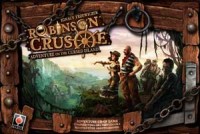
Robinson Crusoe: Adventure on the Cursed Island
Overview (Be afraid…)
In this cooperative game of survival, players find themselves stranded on a mysterious island. They must coordinate their efforts and actions to accomplish the goal of a specific scenario. To do so, players make their way through six different phases to hunt, build items, gather resources, explore the island or simply rest to regain strength and health. Finding food is a necessity. Events on the island will present threats and challenge player morale. Weather will threaten their wellbeing and when night comes, players must have shelter. If too many things go against the players, morale will drop and affect everyone’s ability to succeed. It’s the ultimate cooperative experience because the loss of any single player will end the game for everyone.
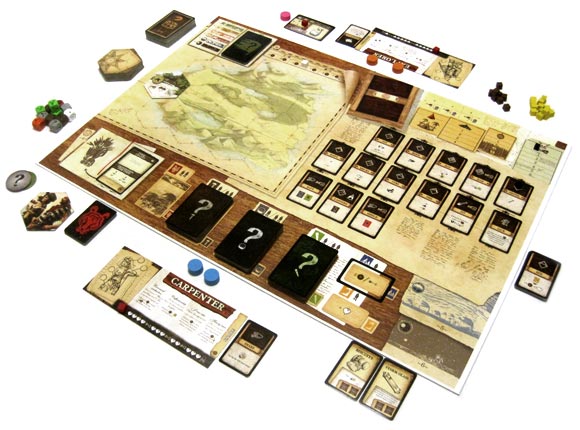
Set up (Welcome to the Island)
Note: There are 20 steps to the setup of this expansive game. This section has been abbreviated for your reading pleasure.
One main set up requirement for Robinson Crusoe is choosing the scenario. The Scenario card lists the number of rounds played, the weather conditions and several other aspects of the scenario, but most importantly it lists the scenario objective. Each scenario also may have its own specific set up. Once chosen, there are some common steps to take.
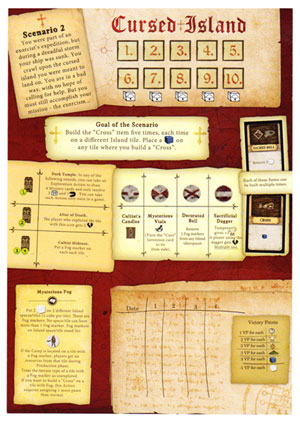
Players draw a random character card and take that character’s starting invention card. Players also take two matching action tokens of any color they wish and a red wound marker which is placed on the leftmost space on the character’s health track. The Morale for the group begins at 0 on the game board and 14 Invention cards are randomly placed face up on the game board. The Island tile marked with the number “8” is placed face up in the left most hex on the game board and the remaining tiles are shuffled and placed nearby. In addition, various other decks are shuffled and placed in their respective spaces. Other tokens, cubes, markers and dice required to play are placed nearby. The youngest player goes first.
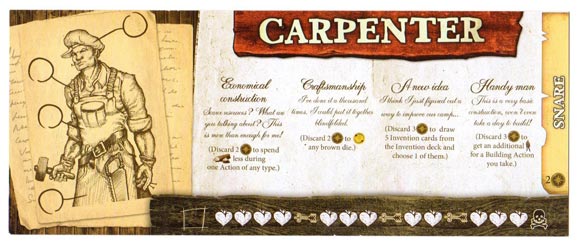
Gameplay (What could possibly go wrong?)
The game objective is quite simple: survive long enough to complete the scenario objective. The game is played over a number of rounds determined by the scenario card. Each round is divided into six phases that must occur in order
1. Event Phase
Draw the top card from the Event deck and resolve the card’s Event effect, then place it on the right space of the Threat Action field on the board. If there is already a card there, slide that card to the left. If there is an Event card on the left space, this card slides off the board and is discarded resulting in the Threat Effect occurring…bad.

During the course of the game, Adventure cards may be shuffled into the Event deck. The text on these cards must be resolved, then a new card is drawn until an Event card is found.
2. Morale Phase
Look at the Morale level on the main board. The first player may have to lose or gain Determination tokens depending on the current level.
3. Production Phase
Players now take the resources depicted on the Island tile where their camp is located. These will either be Food (yellow tokens) or Wood (brown tokens). Resources are placed in the available resources space on the main board and are available for immediate use.
4. Action Phase
There are 7 different actions players may take. This is signified by players placing their pawns on the appropriate spaces on the board as listed below. Each action has a specific benefit:
- Threat Action: By placing a pawn on the Event card, players attempt to avoid the effect of the Threat (Usually by discarding resources). After which, a benefit is often gained. The Event card is then discarded.
- Hunting: If there are any Hunting Cards in the Hunting Deck on the main board, the top Beast card is revealed and must be fought by comparing the strength of the beast to that player’s weapon level. The beast may cause multiple levels of detrimental effects (mainly wounds!), then the card is discarded.
- Building: One of the key aspects in surviving the island is building things. Mainly a Shelter, Roof, Palisade, Weapons which are located on the main board and Items which may be on the main board, Scenario card or on a player’s character board. Items built are either marked with a black token or placed in the Future Resources space on the main board. Most won’t be available to the player until the Weather Phase. Nearly all of these items give bonuses or protect the players from the elements of the island. Weapons help players Hunt; gaining them food to survive. A Shelter, Roof and Palisade will protect against the Weather.
- Gathering Resources: Placing a pawn on the Island tile above a specific resource will give the players that resource for later use. Place that resource token, (Food or Wood) on the Future Resources space on the main board.
- Exploration: By placing Action pawns in empty Island tile spaces adjacent or one tile away from the current camp, a new Island tile is drawn and explored. This may provide the players with new resources, perhaps a shelter (naturally occurring like a cave), Discoveries and Mysteries. It will also be of a specific Terrain Type that will allow players to “unlock” certain items.
- Arranging the Camp: A Player that chooses to place their action pawn here, cleans up around the camp, gains 2 Determination tokens and raising the group’s Mora by 1.
- Rest: Placing an Action pawn here will heal 1 of that player’s wounds.
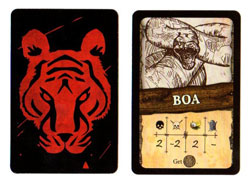

After all actions have been resolved, the pawns are returned to their players and all resources are moved to the “Available Resources” space.
5. Weather Phase
During the Weather phase, first it is determined if there is any weather that will occur on the island, then those affects are applied.
To see if any adverse weather conditions occur, the Scenario card may dictate a number of Weather dice that must be rolled depending on what turn it is. Weather dice have two specific results: Rainy Clouds and Snowy clouds. If rolled, matching tokens are placed on the Weather space on the main board. Then the weather affects are suffered. Depending on the player’s levels of preparedness, they may lose food, wood as well as receive wounds. Hungry Animals and Storms may also occur, each reducing the players’ resources and protection.
6. Night Phase
Five specific things happen in the Night phase:
- During the Night phase, all players will have to consume 1 food resource. Those that do not receive 2 wounds.
- If the players do not have shelter, they each receive 1 wound for sleeping out in the elements.
- Players may choose to move their camp to an adjacent tile.
- All perishable food rots, and must be discarded.
- The Round marker is then moved on the Scenario card and the player to the left becomes the First player.
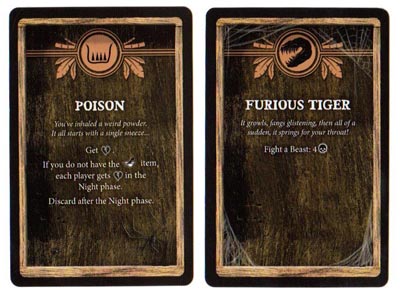
Because of the many effects from Event cards, Threats, Island tiles, Items, Weather, as well as each players individual character card, many, many different effects can occur in a single Action step. The rules covering these different effects are expansive and specific and too numerous to include here. But Players can avoid these detrimental effects generally by communicating, planning and gathering and using resources to build and protect themselves from the various threats the island will hurl at them. Coordination is the key.
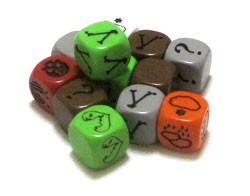
Tempting Fate (Are you kidding?)
Many actions don’t occur automatically. To make matters worse, Action dice must be rolled to see if that action is successful. But that’s not all. There are three different dice (Success, Wound and Adventure) for each of the three actions; Building (brown) Gathering (blue) and Exploring (green). When an action is called for a player rolls the three dice and reveals what their effort has wrought. Since each die has symbols specific to its type, it is possible to roll a success (on the success die) yet receive a wound (on the wound die) and receive and adventure (on the adventure die) – and of course, any combination thereof. Here all of the player’s careful planning can go quickly awry.
Winning or (probably) Losing
All players will win the game if they fulfill the goal of the scenario within the allotted number rounds. If not, the game results in a loss for everyone. The game also ends in a loss immediately when one character dies from their wounds. Thank you for playing.
Components
As with many Z-man games, the production quality on the game is excellent. Strong thick tokens, vibrant colors, durable cards. The art and graphics on the game are wonderful thanks to a team of 5 talented artists. The antique fonts, the 19th century look and feel and the “explorer’s notebook” style art, gives the game an immersive, thematic environment perfect for the subject. The rule book could have been better however, with mediocre formatting that made navigating the first game a bit like a exploring a cursed island.
Learning Curve
Ouch. This game has a lot going on. And due to the less than intuitive rule book, learning the game is almost as difficult as winning it. Once played however and mistakes made, the turns and game play become easier allowing players to become more proactive than reactive as they learn the games timing. Allow several reads and game sessions till you really get it.
Who would enjoy this game?
Final Thoughts
Cooperative games have become a staple in the hobby games industry. From true co-op to semi co-op to a traitor mechanic. Their key attraction is offering a shared experience. Another attribute is that certain themes truly come alive through cooperative gameplay. So it is with Robinson Crusoe. This game brings together a few elements that make the game a unique experience when compared to other cooperative games. The first and most obvious of these is a creative blend of the co-op with the resource management and worker placement mechanics. But let’s dig deeper.

The next difference are the scenarios. Each of the 6 different scenarios have their own special set of circumstances for setting up the game and achieving victory. Most importantly, they set the tone for the entire play experience. From building a signal fire in Scenario 1 ”Castaways” to rescuing a hapless shipmate named Jenny from the rising tide in scenario 3, to surviving the attack of “Cannibal Island” in scenario 5, the level of difficulty increases as the players’ ability to problem solve and master the mechanics increases. Each scenario also provides key game effect explanations for some of the icons used in the game. For example, when exploring the island, the icon of a Totem may appear. In Scenario 1 these have no effect. (lucky you!) But in scenario 4 “Volcano Island,” each encountered hex with a Totem icon has a different discovery. (A small temple or a hidden cave!) In some scenarios, they are nothing but bad news. This is a brilliant design. Instead of playing the same existing set of circumstances, and attempting to achieve one specific goal, (which may result in a dominant strategy) the “goalposts” keep moving. One can almost certainly imagine player-made scenarios and expansions which use the base mechanics and create an entirely new tale. Like a stage awaiting new scenery, lights, plot and script to create an entirely new theatrical experience.
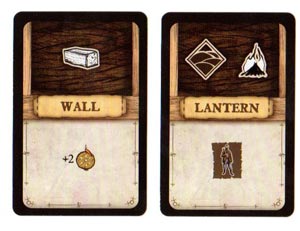
The game also has its own “tech tree” to a degree. Items are key to survival, and many items require other items to build. All items are keyed to a certain land type depicted on the Island tiles. This forces you to expand and explore hoping find what you need. But more important are the two major threats in the game. No, not Bears and Tapirs; Hunger and Weather.
Ignacy has used these very simple concepts to provide a sense of dread as each day comes to a close. First, as the weather worsens, your shelter, roof and palisade had better be built up otherwise your wood and food will disappear as your characters struggle to keep warm and healthy. As night falls, if you don’t have food for everyone and at least some sort of shelter, characters will take up to 3 wounds. It is harsh (hey it’s a CURSED island!), but what this does is provide a huge sense of urgency during the first 4 game phases. It’s a great technique to achieve an emotional response.
The unique way in which Adventure cards are shuffled into the Event deck is inspired. Events happen and produce threats that must be attended to or dire consequences occur. But, in the course of the game, if an Adventure card is drawn as a result if a die roll, the card is shuffled into the event deck. You know it’s in there, you know what it is. You just don’t know when it will occur. Sometimes the Adventure card even dares you to put it in the Event deck. Cursed island!
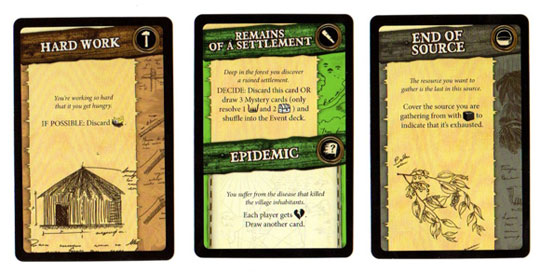
Besides all the great mechanics, the flow of the game, the astounding number of random elements that come together and the truly well written thematic flavor text, the real success of this design is that this game simply creeps you out. It’s as if the game wants you to start off feeling completely doomed then teases and prods you along with small glimmers of hope. The game produces a dramatic response like a well written thriller. Then the game, like the island in Defoe’s novel, starts to breathe and threaten and take on a life of its own. Every player will then find themselves whispering to themselves the words Robinson Crusoe stated: ‘I am cast upon a horrible desolate Island, void of all hope of Recovery. But I am alive, and not drown’d as all my Ship’d Company was.”
It’s good to have a positive attitude.
User Reviews (10)
Add a Review for "Robinson Crusoe: Adventure on the Cursed Island"
You must be logged in to add a review.


“Hey hun, what’s your favorite thing about Robinson Crusoe?”
“LOSING!”
Okay, not what I was expecting. So, Robinson Crusoe has a special place in our hearts as the first board game we played together – and she considers it the first board game she’s played, because Munchkin doesn’t count (neener neener neener).
We were introduced to Robinson Crusoe by another gamer couple who are great friends of ours. It was fantastic to have players who were familiar with the game guiding us through our first play, and we even won! Picking up a copy for ourselves was a no-brainer. We’ve played it about six times now, always the first scenario. We’re hoping to play it more frequently in order to really get the rules down and feel confident playing the next scenario (of six!).
How does it look?: Robinson Crusoe is a lovely game. The components are mostly high quality. As pointed out in other reviews, there are a number of plastic cubes that feel out of place with all the wood (including wood cubes!), but it’s not enough to seriously detract from the gorgeous illustrations. The board is a lovely map of the deserted island that will be filled in with tiles over the course of play.
The many cards are of good quality. The text is all legible, although small on some. The flavor text is all great and fits into the themes of mystery and exploration that suffuse the play experience. The tokens are nice as well, with iconography that generally makes sense without needing a rules reference.
How does it play?: Robinson Crusoe is, at its core, a resource management game. Each scenario has its own unique goal which the players should be working towards. However, the elements and hunger add a sense of urgency and pressure. Feeding everyone means spending actions gathering food, or investing early in inventions that will provide food. However, if the players spend too much time worrying about just getting by turn to turn, they’ll get tighter on time to finish their scenario objective. It’s a matter of balance – starving for a night means taking damage, but can get you that much closer to building a wood pyre to signal a passing ship!
Actually getting things done is a matter of risk management. Each player has two pawns. Most actions require one pawn to attempt, but put the player at risk of taking a wound and/or getting a random adventure (generally, but not always, a bad thing). However, if two pawns (from one player or two) are used on the action, it’s a guaranteed success. Sometimes you’ll want to play it safe, but other times you just need to spread out and get a lot done. Just as with gathering food, it’s all about maintaining a skilled balance.
Overall Impression: With its emphasis on decision making and risk management, Robinson Crusoe is not an easy game to win. It is absolutely driven by skill and experience. It’s the sort of deep, thematic experience that necessitates repeat plays in order to really “get” it. However, with at least one player who knows the game, it’s not all that hard to teach. It made for a fantastic first foray into hobby gaming for my girlfriend, and we’re looking forward to sharing it with others. If the idea of getting trounced a few times doesn’t scare you, I would highly recommend playing Robinson Crusoe.
If your idea of being shipwrecked on a deserted island involves enjoying the weather and sipping out of a coconut shell while idly waiting for a cruise ship to pick you up – this game will shatter these silly expectations with a heavy reality check.
In this co-op 1-4 players take on a role of survivors stranded on an island. The game comes with six scenarios each including the specific circumstances of your shipwreck and the goal you are trying to achieve. The variability of the scenarios offers great replay value as you are not going to be blowing through these.
The game is very complex with several mechanisms interacting to produce the outcomes – worker placement, resource management, ongoing card effects, a tech tree of sorts etc. Each player has two pawns representing their character’s efforts. These can be spent on :
– dealing with the consequences of adverse events from preventing further complications
– hunting (bringing into action a basic combat system)
– building (you can either construct inventions like knives, dams, pots or build up your shelter to protect your group from the elements)
– exploring (opening up new sections of the island or investigating locations of interest)
– or you can spend time resting/tidying up the camp which impacts your morale (despair will kill you as surely as an alligator in this game)
Depending on level of effort expended success is either automatic or you need to roll for it, introducing potential complications such as hurting yourself or an adverse event taking place.
In addition, each character has unique skills based on their class (Soldier, Carpenter, Explorer, Cook) that are fueled by “determination”, a resource that is governed by your group morale.
Each round you need to worry about having enough to feed your group as well as enough wood to keep yourself warm or sufficient shelter to ward away the elements. All the while you only have a dozen or so rounds to complete your scenario objective – if time runs out you lost, but don’t worry – the chances of you surviving that long are slim anyways.
The game has a TON of components of good quality and design. Art is minimalistic but appropriate thematically. Managing all of this will take some time to learn. The rules are not laid out in a good way and a photo guide on how to play is a big help : http://zmangames.com/goodies/Castaways_Quick_Start_Guide_to_Robinson_Crusoe.pdf
It takes an above-average level of game savvy and knowledge of this game in particular to be able to plan effectively. Newer players can be easily overwhelmed by the amount of stuff happening at once and lack of clarity of the eventual impact of your actions. As a result the game is somewhat subject to “Bossy Veteran Syndrome”, however dice rolling and certain individual effects mitigate it to an extent.
If you do make an effort to learn and understand the game however, the rewards are great. The game tells a real story – it flows, has ups and downs (mostly downs), introduces realistic and interesting complications and creates the constant anxiety of how to best use the limited resources you have. It’s many systems, while they do not all gel in the most streamlined way, do combine to provide a very rich and complex experience. For example your characters can suffer wounds that are specific to body parts (that can later become more serious if a cure is not provided) – not many RPGs go into that level of detail, let alone board games!
The game is also punishingly hard. It does not shy away from throwing a real challenge at the players and a win will feel like a real accomplishment. Which is great in my books – in my opinions easier co-ops drain the fun away.
I would suggest this game to dedicated experienced players looking for a deep and rich game and not averse to arcane rules. People looking for a more casual experience will be frustrated and would not enjoy this. The stories you can tell once you get the hang of things are great – through a multitude of potential events/complications and different scenarios the game offers a ton of replayability.
Make the effort and all of the Cursed Island’s miseries will be yours to suffer through 🙂
Everything is out to get you. If you need to draw a card, it’s probably bad. To be honest, you want it to be bad, because it’s either bad, or terrible. There is a mystery deck which can have treasures in it, but even that is mostly traps and monsters. There is a lot of randomisation in the game which helps a great deal with the replayability, however once you have succeeded in completing a scenario once, you probably won’t want to replay it for a while (and currently, the game comes with 6 scenarios and there are 2 additional scenarios available on-line for free as downloadable PDFs).
You can play this solo, however you will actually benefit from other player’s input and suggestions – the game is all about seeing what you have at the beginning of the action phase, and deciding how to use your limited amount of tokens and resources during that turn (and there are a lot of options, which is what makes this game so much fun!).
Each scenario will have a certain number of rounds, but generally between 8-12. 1 round will cosist of 6 phases as follows:
1. Event Phase: Draw an event card (it’s going to wreck you during one of the other phases)
2. Morale Phase: This can be good, but keeping morale positive takes a lot of doing, and if it’s negative, it’s going to wreck you.
3. Production Phase: This is the only phase which won’t actually do anything negative to you, however, if something has happened previously which has forced you to skip this phase….you’re wrecked.
4. Action Phase: This is the phase where you make all the decisions and where all the fun is! But most of the time, you end up making no progress and using all your actions just to heal yourself or collect food so that you don’t starve at night….
5. Weather Phase: This is the phase where clouds will pop out of the sky and wreck you.
6. Night Phase: Got any food? No? Take some wounds. Got shelter? No? Take some wounds.
Sounds stressful? It can be! But it only adds to the satisfaction of beating this*ish island!
On average, you win about 1/3 of the time, and don’t be misguided by the average playing time on the box – a game will take at the very minimum 2 and a half hours, and if you plan on having a tea break, or using the toilet at all, allow up to 6. 4 on average.
If you have a lot of friends to potentially play board games with, then the replayability would be a lot higher than it is, however if you have the same group of friends who you always game with/always solo games, then you will probably complete each scenario once and then let it gather dust for some time.
I highly recommend this game as it is a lot of fun, however do be warned with regards to the aforementioned.
Conclusion: Get wrecked!
I played this game with a group of my friends that enjoy complicated games with lots of strategy. While we didn’t win the first game or even make it to the end of the scenario before losing, there was a very steep learning curve. By the fourth round, everyone had a good idea of how the game mechanics worked and what we should be doing to meet the common goal. One friend said that it reminded them of Camelot, minus the saboteur.
This game does require patience for new players. There are quite a few things going on that can throw a wrench in to a well laid plan. If one player gets too impatient and wants to hunt with a low weapon level or focus only on crafting when their character specializes in exploration, they will more than likely pull down the group as a whole very quickly and make the chances of success very low.
The replay value of the game is very high due to the chance and luck aspect that is given with card draws and dice rolls. What worked one game may not necessarily work out as well the next time. While the components are of good quality and durable, one would expect a box with more organization or bags to handle the numerous pieces so they aren’t all jumbled. If you have a veteran player, the game is easy to learn as they will help guide the group through the different phases of each round. While it is not impossible to learn alone, patience and an open rule book are a definite must to properly learn the mechanics. The game also suggests different house rules if it is deemed too difficult, which can include extra starting items, adjusting what what weather dice and how many are rolled, extra “filler” players such as Friday (a native of the island) or a dog (a possible castaway like yourself).
While this game may not be pulled off the shelf very often, it is still one that can bring a group of people together to attempt to survive an unforgiving island and is a definite buy for people looking to get immersed in a great story telling adventure.
You may be mistaken by approaching this game expecting wholesome Disney japes on a jolly little island complete with white sands and postcard palm trees. No, think of this more as Robinson Crusoe by way of Joseph Conrad with a hearty chunk of 70’s Italian mondo exploitation cinema. Crusoe is a fascinating, complex and ruthless experience that has amassed a body count among my many plays to rival Schwarzenegger in his heyday. And like those grainy video delights of the 80’s it’s a guilty pleasure with which I return regularly and always leave the experience with a big dumb smile on my face.
A word of warning. This can be a complex game, the relatively slim but wordy rulebook appears at first to do an adequate job of getting you going. However, as you progress through the six included scenarios mechanics start to grind noisily against one another followed by the questions and furious consultations of the text, soon it becomes apparent that there’s some explanation missing. And while the manuals inadequacies can’t be ignored in truth it never had a chance when faced with the spiraling array of variables that the game erupts like a soundly beaten pinata. Fortunately nestled deep in the labyrinthine depths of BGG resides a Hitchhikers Guide To The Island FAQ diligently waiting to allay your confusion. (link to FAQ added by Chris 8/7/17)
Each of the games scenarios comes with its own reference card artfully themed to set the scene. Each functions as an addendum to the rules including specific setups and equipment. Cleverly these also customize how much of the games components function completely altering the effects of tiles and tokens you will encounter during that specific story. It’s a neat idea which enables significant altering of the gameplay in fascinating and quite different ways while not tinkering with the primary rules it’s a really simple yet effective piece of design.
Each round breaks down into phases, some are just bookkeeping exercises while others involve hard decisions and suffering with the repercussions.
First up is the Event Phase. An Adventure card is drawn from the deck presenting a dour situation and an instant negative effect on the game, some also feature icons relating to the scenario further compounding the misery. There is always a way to alleviate this carnage in the form of an action that can be taken later in the round, but as we’ll soon see that is not an easy decision. And just for extra giggles they become time bombs queuing at the bottom of the board, that when pushed off by subsequent cards give the knife one final twist. Each card not only oozes story with their stakes-raising cliffhanging situations but also passively aggressively forces you to gamble with how long you’re willing to risk leaving them before having to do something.
After all that ruckus it’s time to settle down with some accounting as we balance the camp’s morale. If you’ve assembled some happy campers, you gain Determination tokens which function as a sort of karmic currency used for your characters special abilities or rerolls of the dice. Then things come over all Euro in the production phase where you scrape together the meager offerings of food and wood from your camp location before it’s off to the Action phase.
Here is where the dark beating heart of the game lurks in a worker placement by group vote. Once again this simple process is fraught with dangers but first you must agree on whose dealing with those Adventure Cards, building, exploring, gathering resources, hunting or staying at the camp to rearrange the twigs.
If only one worker has been assigned to a task, then you have to roll the three dice relevant to that challenge. Like ill-tempered doppelgangers of Donald Ducks nephews, these dice have got it in for you. Bumpy dictate’s if you receive any wounds during your hamfisted attempts, Lumpy decides whether you actually managed to complete what you were trying to do in the first place and then there’s ****. **** is unbridled chaos concentrated into a die while most of its faces are blank scattered among them are “?” and trust me when I say you don’t want to roll those.
What then if fate takes a dump on your plans and a “?” is rolled. Well, each task has its own deck, like the Adventure cards they come with two surprises. The top half will set the scene, maybe a rampaging Gorilla has blustered into the compound, or you’ve found a snake in your boot. There will be an instant effect detrimental to the camp your equipment or even you. Unfortunately, that’s not the end of it. These cards are then added to the Adventure Deck it’s given a shuffle and you then get the agonizing wait for them to reemerge. Eventually, the repercussions of your clumsiness will catch up with everyone. That snake bite from earlier yeah, well it got worse, and now your friends are holding you down while they lop off the septic bit.
This mechanism adds a punishing push your luck element to these tasks, do you concentrate your efforts thus limiting what you will accomplish to guarantee success or spread your efforts in the vain hope you’ll get lucky. And the game knows to stand any chance of successfully accomplishing everything your require to survive you’ll going to have to gamble. It waits like a benign psychopath for you to get careless or desperate enough to try and then has its sadistic fun.
Now if you thought for a moment that all this adventuring and high jinks were all you had to worry about than think again. Because following a hard day of amputation and gorilla wrestling, there is also the little issue of dinner. Hopefully, you had the foresight enough to ****** some coconuts to feed everyone, if not then you can serve up a further plate of misery.
So knackered, famished and that leg stump smelling faintly of almonds now at least you can settle down for a peaceful nights sleep… um, not sure how to put this. Well no you won’t.
Now it’s the bloody weathers turn, yep more dice serving up a delectable assortment of fog, snow, driving rain and hurricanes. The elements hit in the final third of most scenarios and this looming dark cloud will decimate any camp that hasn’t been adequately prepared. If all you have for protection is a large leaf and a scattering of twigs expect a cheery dose of hypothermia with a side order of death. Bear Grills would last about two minutes in this place I’m telling you.
So that may sound like an unrelenting misery inducing horror show, and in truth anyone not versed with the brutal nature of most co-ops will sensibly bolt when first faced with this monstrosity. But even as you panic and stress and invariably perish you know what else is happening you’re having a riot. To survive you have to work as a team if you try and go it alone then the story of you will be short. Coming at this from my video game roots it’s like one of those old-school platformers, or for more modern audiences Dark Souls. It’s going to kill you and often, but slowly you can learn from those mistakes. When you finally manage to get off the bloody island there is a real sense of accomplishment, you’ve seen the heart of darkness and can easily understand why Kurtz came over all Marlon Brando.
This is a complex and at first indecipherable stew of Euro, worker placement, choose your own adventure, sandbox, and survivalist training tool. Ignacy has literally thrown the kitchen sink into the box with mechanics and rules wrestling and tripping over each other to create this gloriously insane perfect storm. Your first plays are going to be head-bangingly frustrating every time you think you have a handle on things you’ll spot a missed rule or be forced to dive into that bloating FAQ. Then around the third or fourth play the clouds of confusion clear and with this new clarity it becomes personal and you’re battling the game and you want to win. It’s an unrelenting ******* and if you gouged at its flesh, I guarantee you’d find the metallic endoskeleton of a remorseless killing machine waiting beneath.
My group of 3 dedicated board gamers really enjoyed this game. I play with these same 2 people every single Saturday and most every time we are trying to defeat each other so it was very refreshing to play a fully co-op game that we weren’t entirely bored with after 1/2 a single play through. I have never honestly been challenged by co-op games and thus don’t find much enjoyment out of them.
Robinson Crusoe on the other hand was very fun and refreshing. It was first off a little more challenging than others I have played in the past. While we still won pretty thoroughly we enjoyed the trip the entire way there and didn’t KNOW we had won until the 2nd to last turn. But winning or losing wasn’t really the enjoyment that I think we got out of this one, it took us beyond that, which is rare for a game in my group. I found myself wanting to tell the little story of the island we were on. Reading some of the flavor text and then mangling it into the story of our journey on the island. My group normally is not this way with games, we are very mechanical and tend to save the story telling for our RPG sessions.
I also have to say that almost every component this game has is awesome. With the exception of one (well 3 kinda) set of cubes that were made out of plastic instead of wood for no reason at all that I can think of. Several other sets of cubes are wooden but these were randomly plastic and poorly made plastic at that. The shapes were shifted badly on some of the cubes and they just feel so cheap next to the wooden ones in the same box. I gave this game a 4/5 for components instead of a 5/5 entirely thanks to these pieces. Everything else is very well made.
My biggest complaint about the game is going to be replay. The game comes stocked with 6 missions, each of which I would assume would take about 1.5-2.5 hours. The game clearly seems to think that you will enjoy replaying these missions over and over again but I just don’t see it happening. I suppose that many many things will change between different playthroughs but I really don’t think that any of them will amount to a vastly different experience. One of the key reasons for this is a lack of veriety in other things. There is exactly 1 unused island hex, meaning that if you fully explore the island in your playthrough you will have seen all but a single hex that the game has to offer. I think that my group will really enjoy playing the 6 missions but after that the game will most likely stay on the shelf almost entirely.
I am hopeful that well priced expansions will come out and give me more missions and tiles and stuff but I would not be excited to pay too much for these kinds of expansions.
Lastly, I want to discuss learning the game. My group had a little trouble with this but we had some one who normally doesn’t explain the game doing the explanations for it, which I don’t think went too well. The player who normally does this claims this would have gone better for us if it had been explained better. Hence the 3/5 right down the middle with that one.
Lastly I don’t know if this is allowed (if not let me know and I will happily remove this part) but I have posted this review on my blog and SHOULD have a weekly review of whatever game/s we have played up there:
http://mythosgaming.wordpress.com/2014/08/12/robinson-crusoe-chriss-review/
In theory this is a co-op game but in reality this is a solo puzzle game. The rules are dense, poorly written, and part of the struggle with the game. The art and components are top notch. Once you understand it, it is a blast. But it takes a while to play a game (and that is even if you don’t count the substantial setup time on this thing). The game works beautifully with any number of players in theory but given that in most co-op environments an “alpha” player would just start bossing people around…likely best played as a solo game. If you enjoy (or frankly are in a situation where you have no choice but to) solo play, this is the game to add to your collection.
DOWNLOAD THE TURN SEQUENCE CHEAT SHEET…watch a play through on youtube…and then enjoy this fantastic game.
This is a great combination of coop/worker placement/story telling game. Lots of mechanics working together to make a challenging struggle for survival. It has so many good ideas, and if you enjoy the game, with so many varied scenarios available, it has lots of replay. I wanted to l0ve everything about this game, but…
1) The manual is clunky. The game is hard to learn, harder to teach. Experienced players will get it after 2 plays, and be able to run with it afterwards, but teaching light to medium players can lead to frustration and people not willing to play again. Download online resources to learn, play, and walk you through the first scenario.
2) Form over function – a pet peeve of mine. The look of the game is great, but neither consistent or clear. For one, brown writing on parchment(off white/tan) is terrible, and the constant changes in fonts and sizes on cards, peripherals make things hard to read. The washed out colors, and general sepia tone to everything may be thematic, but negate contrast and clarity -combined with lots of flavor text and flare can create a static filed of visual noise especially if the game runs long or late with tired players. Symbols that are key elements in the story telling are often small and hard to see. Symbols are not always obvious what they are.
3) Components – Some wooden parts, then there’s generic CHEAP plastic white and black cubes, which are to be used for various things instead of specific colors for specific actions or resources. There’s several decks of cards with dozens of cards in each, including item/invention cards, but some scenarios have unique item/inventions required and instead of having addition cards for these, these are printed in miniature on the scenario cards. Determination tokens (an important mechanic) don’t match the symbols on cards or the game board.
Players I know actually buy pieces to replace those supplied with the game – Upgrading the tokens with more obvious pieces, printing decals for player pieces, printing out a pile of help materials from online.
The clutter, making a hard game harder, is why I may play this game with friends, but not buy a copy for myself.
The game has so many wonderful ideas, but some poor executions. I hope a later edition may address these issues. If you like worker placement and a coop game with the kind of desperate finality of Pandemic, this is for you, but try before you buy…
Robinson Crusoe is definitely a cooperative game, but it nicely avoids the “expert controls group” trap. Everyone has somethings they’re good at and they should definitely play to those strengths most of the time. Everyone in the games I have played felt like they were making their own decisions and yet contributing to the good of the group.
I think Robinson’s greatest strength, however, is the story it tells. You could just look at the numbers and crunch the stats, but you will far more likely describe the situation as the time when that gorilla wandered into camp and destroyed that slingshot I had been working on for two months!
Replay – very high since you have a bunch of scenarios included, plus some to download from the publisher, plus a newly-released expansion. Even the scenarios you have already played will be different each time.
Components – high quality board, tiles, cards, and bits
Easy to Learn – you will need the rulebook close at hand the first time or two you play this. Remember, this is a Polish game!
Give this one a look! Wife friendly.
Robinson Crusoe was a total surprise to me. A friend broke it out on game night and I was instantly hooked on it. Robinson Crusoe is an amazing survival cooperative that really tests you as a gamer. It’s themes are strong, the art is great, and overall, it’s a spectacular game. If you are going to play it though, it can be a little difficult at first. Here’s what you need to do.
1. Get someone who has already played the game and messed it up a bunch so they really know the rules.
2. The best way to teach this game, is to just play it through with a new group several times (it takes more than a few).
3. Never play it unless you have a Robinson Crusoe pro with you.
I’ve played this game several times now, and tried different scenarios and I’ve loved every game we’ve played. That being said, I know I couldn’t right now pick it up and teach a new group. I’m not sure exactly what makes it so difficult to retain the knowledge of Robinson Crusoe, but for some reason it’s not like a bicycle. If you stop playing, the island will make you forget how to play.
Trust no one.
Lost.